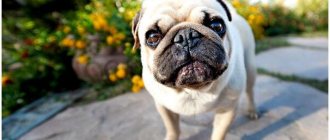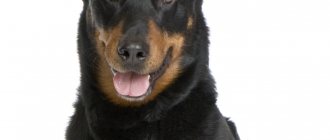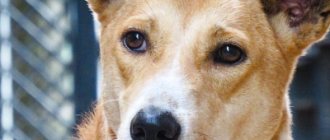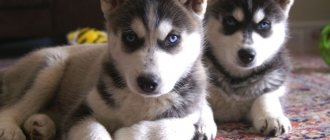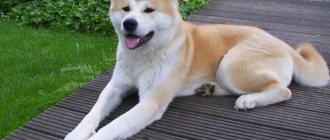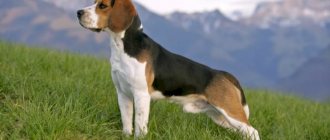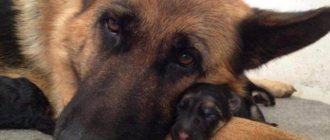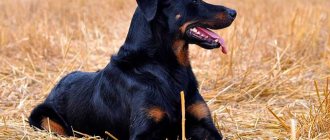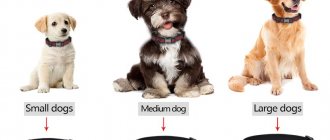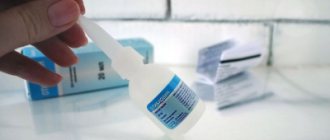The American Staffordshire Terrier is a breed developed in the USA by selecting small baiting dogs from European countries. Bulldog and terrier crosses were carried out to create an aggressive and courageous dog. The result exceeded imaginable and unimaginable expectations. The American Staffordshire Terrier was originally called the Bull Terrier, indicating its origins in the Bulldog and Terrier.
There are debates regarding the origin of the terrier; there are a number of contradictions in the history of the dog. The Stafford is a cross between the aggressiveness of a bulldog and the endurance and mobility of a terrier. What can we say, the dog turned out to be truly harsh and cruel.
A completely reasonable question arises: why did the British need such a dangerous dog? The answer is extremely simple. In the 19th century, dog fighting actively gained popularity, promising great income for the organizers. Gradually, betting moved to the USA, Mexico and even Canada. The Staffords showed fearlessness and tenacity in fights, shedding blood for the amusement of those around them. A truly monstrous sight.
The dogs did not stop fighting. Even serious wounds did not knock the dogs down and the dogs continued to fight like true fighters. This is a proud and strong breed, improved through selection many times. The names were constantly changing. The Staffordshire Terrier was previously called the Bull Terrier, Pit Bull Terrier and even the Brindle Bulldog. The name of the new breed did not affect the character of the breed - a living machine for endless battles and bloodshed. Keeping an animal at home was considered crazy, to say the least. Years passed, centuries changed. Staffords began to appear in private homes as staunch and hardy guards.
The pet received its modern name - American Staffordshire Terrier - only at the end of the 20th century. At the end of the 19th century, the breed was given its current appearance.
The role of the ancestors of the breed was played by the English terrier and bulldog, successfully crossed by American breeders. As a result of scientific work, the pit bull terrier breed was born, which served as the further creation of the Staffordshire terrier dog. Today it is customary to shorten the long name; the dogs are more often known as Stafs or Amstafs. Pets appeared on the territory of Russia recently - at the end of the 20th century.
History of the breed
The American Staffordshire Terrier as a breed was formed only in the 70s. They were often called Yankee Terriers, Pit Dogs, American Terriers and American Bull Terriers. The closest ancestors are considered to be pit bull terriers and other fighting dogs brought from England, Italy and Spain in the 19th century. Initially, they were bred for dog fighting and baiting animals, which is why they were made muscular, tall and with a developed dental system. After dog fighting was banned, they began to be used for security. In Russia, the American Staffordshire Terrier was popular in the 90s. Nowadays they are also famous and popular.
Short description
The Staffordshire Terrier gives the impression of a large dog despite its very modest size. He is both elegant and strong, powerful, stocky, muscular, with a wide chest, a voluminous neck, and a wide skull. The ears are set high (usually cropped), the eyes are small - round and deep. The jaw is massive and strong. The staff's bite force, provided the bite is correct and has a full set of teeth, is approximately 22 atmospheres. Height and weight must be proportional.
The coat is short, shiny, without undercoat. Any coat color is allowed (except white) - solid, colored, spotted. The most popular: brindle, brown, dark red, blue (gray), black.
Character of the American Staffordshire Terrier
- Expressive
- Selfless
- Fearless
- Stubborn
- Devotees
- Smart
- Independent
- Obedient
- Active
- Energetic
Many character traits, including a dog’s balance, depend on upbringing and living conditions.
What conditions make up a dog's character? It is widely believed that the character of a four-legged pet is determined at the genetic level. Also, many people close to cynology argue that character traits are nothing more than the consequences of training and daily upbringing of a puppy. The conditions under which the pet is kept also play an important role. You should not expect your pet to be sociable and friendly towards people if he has been shouted at since childhood, waved at with a leash, or with a newspaper.
Experienced dog breeders will certainly say that if you want to achieve mutual understanding with your own pet, then you must match in temperament and in some character traits. To correctly choose the breed that suits you, first study this issue theoretically: consider the exterior of the dogs you like, read the breed standard, pay attention to the description of the temperament and characteristics of the breed's behavior, ask questions to the real owners of the breed you are interested in. If, in theory, you are satisfied with the breed of your future pet, go to a nursery, or to people engaged in private breeding. A competent breeder who cares about his breed will readily respond to your requests for help in selecting a puppy. It is difficult to say with certainty what kind of character your chosen dog will grow up to be in such a short period of time. There are several simple tests with which you can choose a little friend with the qualities you need.
Photos with examples of colors
The coat of Amstaffs can have different colors, but the most common are the following:
- black - a rich coal-black shade of fur, which even in the light does not have other shades, the presence of small spots in the area of the nose and paws is acceptable;
- black and white – the coat color combines white and black, if white markings are located on the face, neck, back and paws, the color is called “Boston black”;
- blue – the shade varies from light blue to bluish-black; in dogs with a rich blue color, the color of the lobe matches the shade of the coat; if the color is dark, the lobe is almost black;
- brindle - the color of the coat can be brindle or reddish; there are individuals with a rich and even color, with a red or red tint.
In accordance with the standard, any solid color, as well as particolor and spotted, are considered acceptable. White color can occupy a maximum of 80% of the body.
Solid white, black and tan, and liver colors are undesirable, but the AKC standard still allows a pure white coat color for Amstaffs.
American Staffordshire Terrier: features of the breed
- Spend a lot of time . It is necessary to understand that this is a serious dog that requires a lot of the owner’s time. You need to study with her, play, educate, walk and love.
- Companion dog . Currently, this breed of dog has a balanced psyche, without excessive aggression towards people, and is classified as a companion dog.
- A training course is required . The dog must undergo training, including obedience.
- Early socialization . Early socialization is necessary to prevent problems with other animals.
- Not for protecting a large area . The Amstaff is a good bodyguard, but this breed of dog is not suitable for guarding a large area.
- Does not tolerate cold weather . If you have a private house, then in winter you will have to take it home.
- Can be kept in an apartment . Subject to constant, long and active walks.
- Purebred American Staffordshire Terriers are devoid of unmotivated aggression . This is the result of breeders who selected only stable and balanced individuals.
- Active and energetic . If he doesn’t throw out his energy on the street, he will chew everything he can in the house.
- For experienced owners . It is necessary to understand that these are serious and active dogs that require physical activity, education and a firm hand.
What to feed your Amstaff?
Before purchasing, the breeder will definitely familiarize you with this issue. It is very important to initially feed the dog the same food that it ate in its first home, and only then gradually transfer it to a different diet.
If you bought a dog from a professional breeder, then he is 100% likely to buy premium food for his pets, such as Royal Canin, Josera, Hills, Happy dog or Eukanuba.
Gradually, the dog can be switched to processed meat and natural food.
Please note that cheap economy-class food does not contain the vitamins that any healthy dog needs, so you will have to add vitamin complexes to the diet at the same time.
Premium dog food
Health
American Staffordshire Terriers are healthy dogs. Common problems include:
- Hip dysplasia.
- Gastric volvulus.
- Eye diseases: progressive retinal atrophy, entropion, cataracts, glaucoma.
Preventative measures to protect your American Staffordshire Terrier puppy
- To keep your American Staffordshire Terrier puppy completely safe, you first need to minimize his contact with unfamiliar dogs, especially strays. Therefore, you should not let your dog off the leash, as in this case it will become impossible to control its behavior and communication with other dogs. Since a dog can easily become infected with distemper from simply touching the nose of a sick animal. This disease can be transmitted to a dog through sniffing. Your dog can become infected with trichophytosis from contact with the lichen-affected fur of a sick dog. Naturally, it is impossible to completely exclude a dog’s communication with other dogs, since it must be socialized. Therefore, try to find friends with dog lovers who look after their animals. By adhering to this rule, you can eliminate the risk of pathogen transmission by 80%.
- You should walk your dog in places where there are no landfills. Since garbage very often attracts rodents, which in turn are very often carriers of various infections. Gray rats are especially dangerous because they carry such a serious disease as leptospirosis.
- You should not allow your dog to sniff other people's feces, as they are a source of worms.
- Monitor the well-being of your American Staffordshire Terrier. Pay attention to even the most minor changes in his behavior. For example, your dog may appear lethargic, lose his appetite, or have a dry nose. Or you may notice that the dog begins to shed, and this has nothing to do with seasonal shedding. If hair loss becomes excessive, this is the first symptom indicating health problems in your pet. And only you can help him. Therefore, it is important to take the dog to the veterinary clinic in time, where the disease can be overcome for sure. In no case should you ignore the symptoms, since advanced infections are much more difficult to treat, and sometimes even impossible. If you start treating your dog, the disease can lead to his death or he will develop serious complications that will affect his hearing, vision, limbs and much more.
Training and education
Training course required! The dogs are well trained. Having adopted a puppy, you must immediately raise it. There is no need to wait 6 months to enroll in the OKD group. You need to educate from the first days the puppy appears in the house. The dog is people-oriented and obedience training is not difficult. If you have any problems, contact your dog handler immediately.
- All family members should be involved in training the dog.
- It is not recommended to conduct security and fighting training, otherwise the owner may suffer disastrous consequences.
The American Staffordshire Terrier has a high pain threshold due to its fighting background.
Submitting a dog doesn't always work. The principle of complete submission of the American Staffordshire Terrier to the owner is an outdated method. This theory was formulated based on observations of packs of wild wolves, but they were kept in captivity and, of course, experienced stress. The stress condition forced wolves to show aggression towards each other, but in the wild they do not show aggression to each other - they live together and interact with each other. You need to perceive yourself as the more experienced and mature member of the pack, who is responsible for guiding the new member (American Staffordshire Terrier puppy) and teaching him good behavior, as well as correcting him if necessary. It is important to remember that American Staffordshire Terrier puppies learn a lot on their own. They are very inquisitive, love to explore new territories and, of course, experiment. Puppies tend to repeat actions they enjoy (like playing with a toy). They do not repeat actions that cause them pain (for example, destroying a nest and getting bitten). If your American Staffordshire Terrier puppy misbehaves, ignore him and praise him when he does the right thing. Reward your puppy for following commands and good behavior. Do not neglect these tips. After all, constantly hearing “you can’t” all day long is unbearable. This is a small child who wants to know everything and get his portion of treats as a reward for not eating your favorite rug, going to the toilet outside, bringing you a ball, and so on.
Set rules and monitor their implementation
It is worth enrolling your American Staffordshire Terrier puppy in obedience training classes. These classes will allow you to understand exactly what actions will allow you to control your dog’s behavior. You will be able to spend more time with your puppy, establish contact and socialize around other dogs.
Adviсe
- Training an American Staffordshire Terrier puppy should be done with the help of positive motivation; watch carefully special films about this technique. The Canine Translator film series from National Geographic is suitable.
- If you need to leave your puppy at home alone for 2 hours or more, then ask someone to come to him.
- Be sure to schedule your American Staffordshire Terrier puppy for an appointment with the veterinarian as soon as possible. The doctor will carefully examine him and give him vaccinations that will protect him from dangerous diseases.
Rules of care
Proper care of an Amstaff involves not only arranging a personal space and proper feeding, but also regular hygiene procedures aimed at maintaining the health and beautiful appearance of the pet.
Wool and bathing
It is enough to brush the coat of Amstaffs weekly with a stiff brush.
After each walk, you need to wash your pet's paws and inspect them for damage.
Representatives of this breed should be bathed as needed, but not more than once every 8-10 weeks, using a special shampoo appropriate for their coat type. After washing the Amstaff, wipe it dry with a terry towel.
An unpleasant odor emanating from a dog after washing is a sign of a chronic infection.
Ears
Approximately 1-2 times a week, wipe the ears with a cotton pad soaked in boiled water, removing dust and dirt.
If there are plans for ear cropping, the procedure should be carried out within 1.5-2 months; later, the rehabilitation period will take longer.
Teeth
Brush weekly with a special brush and paste for dogs - this serves to prevent the formation of plaque and tartar.
Eyes
Wipe daily, removing secretions and mucus accumulated overnight, with a cotton pad soaked in chamomile infusion, weak tea leaves or boiled water.
Claws
If the claws do not grind down on their own during walks, they need to be trimmed with a guillotine nail clipper approximately once every 3-4 weeks.
IMPORTANT! Also, caring for these dogs involves timely vaccination, deworming and treatment for external parasites.
Where to buy an American Staffordshire Terrier puppy?
A specialized kennel is the best place to buy a good American Staffordshire Terrier puppy. If pedigree and thoroughbred are important, then it is better to hire an experienced dog breeder to help. If not, then you can trust your heart. On nursery websites, there are customer reviews that will help you navigate. A little secret or life hack: visit a dog show where the desired breed will be presented. Chat with the owners of the breed, ask about the nuances, find out where they purchased the puppies. True dog breeders live for their pets, so they will be happy to answer any question and give valuable advice. Typically, nurseries send their representatives to exhibitions, where there is a chance to meet in person and take a business card.
How to choose a strong and healthy American Staffordshire Terrier puppy
The day has come to go to the nursery for a cute puppy. Babies should be kept in a clean enclosure, without a specific unpleasant odor, which is very important. First of all, the breeder will demonstrate the numerous awards that his pets have received. Listen carefully, but don’t be easily fooled by all the big titles and championship accolades. If possible, you need to look at the parents of the future pet. The main 10 signs that will help you choose a healthy American Staffordshire Terrier puppy:
- shiny and moist nose;
- clean ears, pink;
- lively, clear look;
- clean eyes, without any discharge;
- healthy skin, without parasites, sores and acne;
- silky, shiny coat;
- lymph nodes of normal size;
- tail without creases;
- no bloating.
A good proof that the animal is healthy is a written document of purchase and sale. If the American Staffordshire Terrier puppy develops abnormalities over time, according to the contract, the pet can be returned. Having “insurance” with the buyer will reduce the risk that the seller will slip in a problem animal.
Age for adoption
- Professional Russian dog breeders advise buying 8-10 week old puppies. At this age, the baby should already be vaccinated, toilet trained, and receive basic education.
- An important point: it is not recommended to take a puppy home immediately after separation from its mother. Until 9 weeks of age, the baby learns dog language and learns to communicate with its own kind. He needs to spend several weeks in a doggy daycare.
- A professional breeder knows that an American Staffordshire Terrier puppy less than 6 weeks old should not be given away. A very small puppy can only be given to an experienced owner who knows how to raise it correctly. This option is not suitable for a beginner.
- Depending on the breed, the puppy can be picked up earlier or later than 10 weeks of age. Large dogs grow more slowly, so it is recommended to remove them from kennels at the age of 3 months. Puppies of such breeds should gradually build up bone and muscle tissue, without sudden jumps, in order to avoid problems with the musculoskeletal system.
- For American Staffordshire Terrier puppies of show or breeding class, the age of “adoption” can only be 6-9 months. This is a mandatory condition, because it is at this age that the makings of a champion and the distinctive signs of thoroughbred are revealed. You need to have patience to get a future titled champion.
Note : even the most expensive American Staffordshire Terrier puppy cannot with a 100% guarantee become a champion. The breeder’s job is to assess the potential and make a forecast. Next, you need to raise the puppy and train it for a long time in order to realize the makings of a champion.
Documentation
- An American Staffordshire Terrier puppy has a mark in the groin area or it may be on the ear, as well as a puppy card (metric). The codes on the card and on the stamp must be identical.
- Metrica is the primary document that is issued for a puppy when it reaches the age of 45 days. Next, a qualified dog handler examines the babies and notes any defects found. The owner of the dog, if desired, can change the metric to a new document, pedigree, at the age of 6-15 months. This document will allow the pet to participate in breeding.
- Another document for the puppy is a veterinary passport, with mandatory vaccination and deworming notes.
- Games
- Walks
- Hygiene
- Inventory
5
Maintenance and care
Keeping and caring for the Staffordshire Terrier includes such concepts as games, walks, and maintaining the pet’s hygiene. In addition, it is necessary to purchase the necessary equipment.
Games
As has been mentioned many times, Staffordshire Terriers are very playful. Puppies are especially active in this regard, and sometimes their behavior can be tiring. However, you should not lock your baby in a dark and cramped room, as this can traumatize his psyche. Some dog handlers advise putting the naughty dog in a metal cage: he will still be in full view of the owner, but will not be deprived of light, and the effect of cramped conditions will have a positive educational effect.
A puppy should be accustomed to being alone gradually. In the first days, you should try to leave only when the pet has taken a walk, played enough and fell asleep. Having bought a puppy, a person takes on the functions of its mother, so the pet will have a very hard time experiencing the absence of its owner, and a long separation can have a negative impact on the animal’s psyche. The baby will quickly get used to being alone, but at first it is still better to have someone at home, even when the puppy is sleeping.
At the age of 1.5 months, the puppy tries to chew everything it comes across. It is necessary to make sure that the baby has no way to get to electrical and telephone wires, as well as to room slippers. The puppy should not play with shoes under any circumstances, otherwise, when he grows up, they will constantly suffer from his teeth.
Gradually the pet will get used to being alone
During the period of teeth change, you need to prepare special toys for your baby that he can play with for a long time. For this purpose, cast rubber balls, calcined clean brain bones, or specially made imitations of them are suitable.
Sometimes the puppy begins to chew the legs or other wooden parts of the furniture. In this case, you can give him dried pig ears or a piece of a thick linden branch, dipping it in natural wood glue and drying it. It is also useful to give your baby carrots or apples as toys: he will not only satisfy his innate need to chew, but will also receive a small portion of vitamins.
You should not let your pet chew on hollow rubber objects, as he may swallow the bitten pieces, which can have serious consequences. There are many known cases where such moments led to the death of puppies.
Walks
Walking is just as necessary for a puppy as it is for an adult dog. Walking has a beneficial effect on the well-being of a small pet, the formation of its nervous system, and contact with the owner.
The dog owner needs to take the puppy for a walk 2-4 times a day: in the morning, after the puppy wakes up, then at 13-14 hours, and in the evening, at 18-19 hours. It is recommended to walk the dog at night.
Often, city dog breeders do not have the opportunity to take their puppy out during the daytime. In this case, you can limit yourself to three walks a day and feed the dog a small part of the daily diet in the morning. The total duration of walks should be at least 3 hours per day.
Dogs kept in private homes are prohibited from being removed from their property until they are vaccinated.
It is recommended to walk the puppy on a leash, which the pet is accustomed to starting from 2 months of age. Until 3 months, the dog should be carried outside down the stairs in your arms, otherwise there is a risk of deformation of fragile limbs. A puppy should be taught to climb stairs 2.5 months after birth.
When walking a puppy, you should not allow him to jump a lot, as there is a possibility of loosening the animal’s fragile joints.
When walking around the city, it is necessary to teach the puppy to be indifferent to passers-by, not to be afraid of cars, gradually moving with the pet to more crowded and noisy streets.
The pace of walks and the load are chosen by the puppy. You should not force your pet to move if it needs rest, as excessive stress causes deformation of the skeletal system. A good workout for a puppy is swimming, since in water the dogs’ muscles develop evenly and with the correct distribution of load.
You can teach a small pet to swim from 3 months. In this case, under no circumstances should animals be thrown into a pond, since such measures lead to the fact that the puppy will be afraid of water all his life. It is recommended to use a favorite toy to attract him to water. After leaving the water, you need to let the puppy run around and dry off.
The load of running and long walking begins at the age of one, after the complete formation of the skeleton. It is not recommended to allow your puppy near dogs that live outside, as there is a possibility of contracting some disease.
An adult Staffordshire Terrier is walked 2 times a day not only so that he relieves his needs, but also so that he has an extra opportunity to run and warm up.
It is necessary to allocate enough time for walking the dog, since, unlike a puppy, an adult dog cannot empty its bladder at once; it does this in several stages with short breaks. It is especially important to ensure that the dog's natural needs are fully satisfied before training. If this does not happen, the Staffordshire Terrier will become distracted or have a bowel movement in the training area.
When a dog runs too far, it needs to be called back, and when strangers appear, it needs to be put on a leash. If you need to travel anywhere with your dog by transport, it must be muzzled and on a short leash.
If the dog is your first pet, it is recommended to follow some rules when caring for it, well known to experienced dog handlers:
• in order to develop correct posture in the American Staffordshire Terrier, you need to take him on a leash whenever possible and force him to walk side by side so that the animal pulls the owner forward. If necessary, you can give the command “Pull!”;
In some cities, transporting large dogs on public transport is prohibited.
• when going on a trip, the puppy can be placed in a convenient open bag;
• the American Staffordshire Terrier loves to move, so during a walk you need to give him the opportunity to run on flat ground or hills and jump over barriers;
• if it is cold and damp outside, it is better to limit walking with the dog to 10-15 minutes;
• all purebred dogs are very susceptible to many infectious diseases. To avoid infection, do not allow your pet to interact with other dogs;
• during heat, the bitch can only be walked on a leash;
• When walking the dog, it is recommended that the owner himself move more. Games and running will not allow him to freeze and will please his pet;
• the dog should not be allowed to bark at passers-by;
• you cannot walk your pet near children's playgrounds;
• under no circumstances should you let an animal off a leash near the roadway;
• during a walk, the dog can be let off the leash only after it has firmly learned and quickly follows the owner’s commands.
A walk can be turned into a workout, especially if your dog's muscle mass is growing slowly. It’s not a bad idea to force the dog to run, jump over obstacles, etc. High jumps are very useful for Staffordshire Terriers, especially in the first 8 months.
Use a long leash when walking
During the first year, it is necessary to monitor the correct formation of the skeleton and muscle development. To do this, you can spend part of the time allocated for a walk on the dog pulling the owner by the leash, straining the neck muscles (for example, in winter when skiing or in summer when walking or roller skating).
We should not forget that a purebred Staffordshire Terrier should have a wide chest. If it is not wide enough, you can perform special exercises with the dog. A very useful exercise is during which the owner, standing on a hill, throws a stick or a ball, and the dog goes down, finds and brings this object up.
Who walks the dog also matters a lot. Of course, it is advisable for the Staffordshire Terrier to be walked by its owner. He will be able to use his walking time more effectively to raise the dog. True, the owner does not always have time to walk the dog. In this case, any family member can go out with her. However, we should not forget that the Staffordshire Terrier is still a very active, strong and energetic dog. A child or an elderly person may not be able to handle it if the dog suddenly runs into the road.
In order to make the dog jump, you can raise your hand with a stick, a treat, or throw a small ball into the air so that the dog jumps and tries to catch it.
The Staffordshire Terrier sees other dogs primarily as rivals; if they start attacking him, he can easily get excited and bite the attacker. But still, one should not be afraid of the excitability of dogs of this breed: a well-trained dog will stop fighting at the first command from the owner. In addition, practice has shown that he will never attack a puppy or a dog that is significantly smaller in size, or attack another dog first.
In order to avoid problems while walking, it is advisable to keep young Staffordshire Terriers away from large and aggressive dogs.
If a fight could not be avoided (which in reality is extremely rare), you should not stand aside, but intervene as soon as possible and calm the dog. In this case, there is no need to drag the Staffordshire Terrier away from his opponent by the collar, hit him, scream or spill water on him. Such methods, as a rule, turn out to be ineffective. Dogs must be separated at the same time, and both owners must try to calm their pets.
You need to make sure that the dogs don’t start biting each other. If this does happen, you should carefully open the dog's jaws with a flat board (it is not recommended to use metal objects, as they can damage the teeth).
Hygiene
Maintaining hygiene not only helps your dog look good, but also helps prevent a number of diseases. The concept of hygiene includes brushing and bathing, caring for paws, claws, teeth, ears, eyes, nose and whiskers.
¦ CLEANING AND BATHING
The Staffordshire Terrier needs to be brushed daily. This procedure is usually carried out after a morning walk. If he gets very dirty on another walk or during training, cleaning must be repeated.
Before cleaning, you should carefully examine the dog, paying attention to the condition of the eyes, ears, mouth, nose, paws and fur. For cleaning you will need a special brush, a squeegee for removing wool from the brush, a cloth, a clean napkin for washing the eyes and ears, and cotton swabs.
In addition, you will need shampoos to wash your dog. It is not recommended to use detergents intended for humans, since the substances they contain can irritate the skin and mucous membranes of the animal.
Brushes for wool cleaning and massage
You should use special shampoos designed taking into account the characteristics of the dog’s body. They clean the wool well, give it shine and do not cause an allergic reaction.
Cleaning the coat and skin
American Staffordshire Terriers are short-haired, but their coat still requires regular grooming. To maintain the beauty and shine of the dog’s coat, it requires fairly frequent cleaning procedures, combing out dead hair, and massage.
To clean the coat, use a brush with medium-hard bristles: it should not scratch the dog’s skin and at the same time should not be too soft, otherwise it will become difficult to remove dirt after just a few uses.
Before starting cleaning, you should perform a light massage: stroke the dog against the grain for 2-3 minutes, and then in the same direction - against the grain - brush it with a brush.
Cleaning and combing the fur begins from the dog’s back and neck, then moves to the stomach, then to the chest, paws and tail.
During brushing, dust, dirt, dander and dead hair are removed from the dog's coat and skin. This procedure is a good prevention of skin diseases, and also stimulates blood circulation and metabolism.
Clean the dog in this order. Starting from the left side, comb the hair over the entire body in the direction of hair growth. Using a special brush, comb the fur first against hair growth, then in the opposite direction.
Periodically clean the brush using a scraper. Then moisten the cloth with clean warm water, wring it out well and wipe the animal’s fur. Just like when brushing, first make movements against hair growth, then in the opposite direction. Next, wipe the dog’s ears and eyelids with a clean napkin, dry or moistened with water. If the ears are very dirty, you can clean them with a cotton swab dipped in 3% hydrogen peroxide.
Having finished cleaning, you need to take a fine-toothed comb and gently comb the Staffordshire Terrier's coat in the direction of hair growth. This simple procedure is also a kind of massage that helps increase muscle tone and stimulate blood circulation.
After carrying out the above steps, you should clean the used equipment from wool and dust. Animal care items should be washed periodically with warm water and soap and disinfected once a month.
Bathing
Staffordshire Terriers not only need to be brushed, but also bathed. The owner decides how often to carry out this procedure depending on the characteristics of his pet. In summer, dogs are washed more often, in winter - less often, and when there is snow, they clean with snow.
Staffordshire Terriers love to bathe and swim; they get used to this procedure very quickly and do not show anxiety. Swimming in open water is also beneficial for dogs, especially during hot periods. Before swimming, you need to remove the leash from your pet and check that there are no piercing or cutting objects in the bathing area.
Bathing is necessary because brushing does not completely remove dirt and dander from the dog's coat and skin. First, the dog's fur is moistened with warm water (the temperature should be 37-39 ° C), then lathered with a special shampoo or soap and washed thoroughly. If necessary, the procedure is repeated twice. Soap suds must be washed off completely, otherwise your pet may experience skin irritation. Particularly sensitive dogs sometimes develop eczema.
After bathing, the dog should be dried with a towel and not allowed to lie down until completely dry. You can use a hairdryer for drying if the dog has been trained from an early age not to be afraid of its noise and air movement.
You should not immediately take her outside, especially in winter: she can easily catch a cold.
Dogs are typically bathed once a month. If this procedure is carried out too often, the protective fatty substances washed off from the coat will not have time to be restored. Frequent washing of the dog is recommended only if it has increased secretion of the sebaceous glands.
Bathing can be done at any time, but not after feeding. Before bathing, it is recommended to carefully plug your dog's ears with cotton swabs, otherwise water may get into them. It is also necessary to ensure that during bathing water or soap suds do not get into the dog’s eyes and nose.
When swimming in the fresh air, it is not necessary to wipe the fur, since the dog itself shakes off the remaining water with energetic movements. However, after bathing, you should not allow your dog to roll on the ground.
¦ PAW CARE
While walking, dogs often receive minor injuries to their paw pads (for example, by stepping on shards of glass, sharp plant thorns, stones with sharp edges, etc.). Therefore, paws and claws should be examined after every walk. If you find scratches or other damage, treat the wounds with hydrogen peroxide.
It is also necessary to take into account the weak sensitivity to pain in representatives of this breed: the dog may not show any anxiety and at first may not even experience discomfort from glass shards or wooden chips stuck between the paw pads. However, if the foreign body is not removed in a timely manner, serious inflammation of the skin and soft tissues may develop.
You should wash your dog's paws upon returning from a walk in any weather and at any time of the year. Then they need to be wiped with an old towel or piece of soft cloth.
Dogs living within the city often have traces of fuel oil, oil paints, bitumen, etc. on their fur and paw pads. It is very difficult to wash them off with water, even using shampoo or soap. It is recommended to remove such stains with a cotton swab soaked in solvent for oil paints.
Then the animal’s fur and skin, which have been treated with a solvent, must be washed with soap and wiped dry. After this, the affected area can be lubricated with baby cream or vegetable oil to relieve possible irritation.
In winter, when the air temperature rises above 1 °C, the snow lying on the city streets begins to melt. Melt water is mixed with salt crystals, which are sprinkled on roads and paths during icy conditions. The resulting solution, coming into contact with the paws of an American Staffordshire Terrier, begins to corrode the skin of its paw pads, causing dermatitis - inflammation of the skin. To prevent the development of this disease, it is enough to wash your pet’s paws every time after a walk.
¦ NAIL CARE
Nails should also be inspected regularly and, as they grow back, shortened using a special tool - a dog nail clipper or carefully filed using a large three-edged file.
Too long nails often lead to the dog beginning to fall on the front limbs, and, in addition, inflammation of the periungual ridge may begin.
It is necessary to constantly monitor the appearance of your pet’s claws. If cracks, creases, or scratches are found on them, they should be periodically treated with a small amount of animal fat.
The dog's claws are non-retractable. They consist of keratinized epithelial cells. The keratin content in them is very high, which gives them special hardness. The keratin sheath is needed to protect the living tissue inside the claw (claw bed), which contains small blood vessels and nerve endings.
When it comes into contact with the surface on which the dog walks (concrete, parquet, marble), the outer edge of the claw wears off, acquiring its characteristic crescent shape. If the Staffordshire Terrier walks very little, the claw is not worn down enough and its shape is greatly distorted.
If a dog's claws exceed the permissible length, they begin to interfere with the animal's walking and cause discomfort. When moving, the Staffordshire Terrier transfers its entire body weight to its leading paw, stepping on the ground with its entire surface. If the length of the claws exceeds the permissible limit, they will greatly interfere with the animal, forcing it to change its gait to a more comfortable one. This can lead to complete deformation of the paw.
If the Staffordshire Terrier lives in the city, its claws will wear down quite a lot while moving on paved stones or asphalt roads. However, even in this case, the pet’s claws should be trimmed so that they maintain the correct shape and do not split.
This problem especially often occurs in dogs living outside the city, in areas where there are no paved or gravel roads.
The American Staffordshire Terrier's nails need to be trimmed every 4 weeks. The first time this is done is 3 weeks after the puppy is born, since during the feeding process it can severely scratch the mother’s mammary glands.
If your dog has split nails, you need to use a file or nail file to straighten the edges of the claw, and then lubricate it with a nourishing cream.
Immediately before the exhibition, your pet's dull and rough nails can be coated with a colorless, nourishing nail polish. This will give them the necessary shine and emphasize their shape.
To trim claws you will need tweezers, scissors or a nail clipper, a file or a file, several cotton swabs, and a hemostatic antiseptic. When treating your pet's claws, you should be careful, because by cutting them too short, you can accidentally damage the dog's nail bed, which will immediately begin to bleed. If this happens, you need to moisten a swab in an antiseptic solution and blot the bleeding cut with it.
The living part of the claw of a light-colored Staffordshire Terrier with white claws is usually clearly visible, as it has a distinct pink tint. If your dog has black claws and the boundaries of the claw bed are not visible, it is recommended to trim only the tip of the claw and repeat the procedure every 7-10 days.
¦ DENTAL CARE
Maintaining healthy teeth is extremely important for any dog, especially a service dog. Therefore, every owner should monitor the condition of their pet’s teeth.
Tartar causes irritation and inflammation of the gums and has a destructive effect on tooth enamel. This can lead to tooth loss. You can prevent the formation of tartar and get rid of yellow plaque if you regularly brush your dog’s teeth with toothpaste without a strong odor or strong taste. To do this, take a small wooden stick, one end of which is wrapped in a layer of cotton wool, dipped in toothpaste or sprinkled with a special powder made from crushed chalk, baking soda and citric acid.
Dental diseases can negatively affect your dog's health.
After brushing, the Staffordshire Terrier's teeth should be thoroughly wiped with a soft paper napkin and a gauze swab. Under no circumstances should you allow your pet to swallow toothpaste or powder, as this will cause stomach upset.
It is recommended to brush your teeth once every 2 weeks. The dog must be accustomed to this procedure from an early age. To do this, the puppy is first taught the command “Show your teeth!” After the animal learns to perform it, you should regularly examine the oral cavity and brush your teeth.
Inflamed gums are usually treated with a weak solution of potassium permanganate. However, treating this disease at home is still not recommended. It is best to contact a veterinary clinic, where the animal will receive the required help.
The same should be done if signs of caries are detected in the Staffordshire Terrier. If the tooth is very badly damaged, the affected dog often rubs its muzzle with its paws, refuses to eat and begins to chew on surrounding objects.
If small fragments of twigs, bones, tissue or other foreign bodies are stuck in your pet's teeth, they should be carefully removed, using tweezers or dental floss if necessary, as they can damage tooth enamel and injure the gums.
¦ EAR CARE
The ears of Staffordshire Terriers need to be regularly cleaned of dirt and earwax. To do this, you need to first (preferably a day before) using a regular pipette, drop one drop of slightly warmed vegetable oil into each dog’s ear. Then, taking a small cotton swab, moisten it with vegetable oil and carefully treat the inside of the ears.
It is enough to clean your ears once a week, usually on the day of bathing. To do this, drop 1-2 drops of a special liquid, lightly massage the base of the ear and then carefully insert a dry, clean ear stick, making a slight rotational movement.
Heavily dirty ears should be additionally wiped with a swab moistened with a 3% solution of hydrogen peroxide, which can be purchased at a pharmacy.
Earwax and lack of proper ear care can cause diseases
If dark discharge with an unpleasant odor appears in your dog’s ears, the animal often shakes its head and rubs its ears with its paws, you need to contact a veterinarian as soon as possible, as this may be a sign of some disease.
The ear canals can be cleaned of dirt and earwax using small thin sticks wrapped with cotton wool soaked in alcohol at one end. Using such sticks, you should carefully clean the walls of the auricle, but you cannot push them very deeply, as this can damage the eardrum, which will lead to partial hearing loss.
Inflammation of the auricle in a dog in most cases leads to complete loss of hearing.
The fur around the ear canals irritates the ear. As a result, the animal begins to scratch its head and ears with its paws. Dirt carried into the ear canal is the main cause of ear disease, and scratches caused by claws almost always become inflamed.
¦ EYE CARE
Dogs, even completely healthy ones, may develop small purulent discharges that accumulate in the corners of the eyes. They are carefully removed using a clean gauze napkin or soft thin cloth. It is better not to use cotton wool, as the fibers that separate from it irritate the mucous membrane of the dog’s eyes.
More abundant discharge can be caused by strong wind, drafts, dust getting into the eyes, etc. Most often, the eyelids become inflamed if they do not fit tightly enough to the eyeballs.
To relieve inflammation and reduce purulent discharge, infusions of medicinal plants that have a bactericidal effect are used. An infusion of chamomile flowers is best suited. Prepare a decoction at the rate of 1 tbsp. spoon of dry medicinal raw material per 1 glass of water, the resulting product is infused for 15-20 minutes, filtered and cooled to room temperature.
Moisten a cotton swab with the prepared infusion and treat the dog’s eyes, gently rubbing them in the direction from their outer corners to the nose. For each eye you need to prepare a separate swab. The eye wash infusion should always be fresh.
If the inflammation is very severe, it is necessary to drop albucid into the eyes of the affected dog. Throughout the entire procedure, the Staffordshire Terrier's head must be in a fixed position. The eyelids are carefully pulled apart with the thumb and forefinger of one hand, and the drug is instilled with the other. The pipette should be held so that it is at a distance of 5 mm from the surface of the eyeball.
Do not wash dogs' eyes with boric acid solution or strong tea. Small crystalline structures contained in boric acid solution, and small fragments of tea leaves in tea, will irritate the mucous membrane of the eyes.
Even healthy dogs often develop small pus-like discharges in the corners of their eyes, which should be removed regularly with a small piece of dry, clean cloth or soft paper towel. Copious discharge, as a rule, appears if the mucous membrane has been irritated by wind, dust or smoke.
¦ HYGIENE OF THE NOSE AND ORGANS OF TOUCH
You can usually judge a dog's health by feeling its nose. If the skin of the nose is cool and moist, it means that there are no serious disturbances in the functioning of the animal’s body.
A clear sign of the disease is a nose that is hot to the touch, dry and cracked. However, a nose that is warm to the touch is not necessarily a symptom of some disease. It should be taken into account that a certain increase in skin temperature may be observed in the pet after waking up from sleep or after active physical activity.
If your nose is very dirty, you can gently wipe it with a tissue soaked in water or a clean soft cloth. You cannot use alcohol solution or any other liquids with a strong, persistent odor instead of water.
In the same way, if necessary, the organs of touch - vibrissae - are cleansed.
Inventory
The concept of “equipment” includes a collar, muzzle, short and long leashes. They must have certain qualities. In addition, the dog will need food and water bowls and toys.
¦ COLLAR
A collar is necessary to keep a dog. The animal must wear a collar at all times. It is a hard leather tape 1 to 3 cm wide, with a durable metal buckle. The collar should fit tightly around the animal's neck without squeezing it. It also allows the owner to grab and hold the pet if necessary.
The collar begins to be used after the puppy’s bones become stronger. Until this time, while there is a danger of damaging the pet’s neck, it is better to put a harness on it for walks.
Owners of American Staffordshire Terriers are recommended to purchase several collars: a regular leather collar with a double-sided buckle, a leather collar designed for working with a dog (it should be adjusted exactly to the circumference of the animal’s neck), a metal chain collar equipped with two rings on the edges. The latter is used when training a dog, in particular to correct mistakes made by the trainer earlier.
For training an American Staffordshire Terrier, a parforce (strict collar) with spikes on the inside can also be useful. It tightens when the leash is pulled and is used to hold the dog.
Collars with spikes for training
Snatch chain
Along with a regular collar, a choke collar and a snatch chain are used for educational purposes. They automatically tighten around the dog’s neck as soon as you pull on the leash. As the tension loosens, the loop around the neck also loosens. Anyone who uses a snatch chain or choke should learn to do it correctly so as not to harm the dog.
An identification tag can be attached to the collar that contains the name, address and telephone number of the dog's owner.
¦ LEASH
The leash is made of durable leather, leatherette or tarpaulin. Its length can vary (from 1 to 2 m), and its width is usually 0.6-2.5 cm. At one end of the leash there is a loop into which you can put your hand for convenience, and at the other there is a carabiner that is attached to the collar.
When going for a walk with your pet, you should always take a leash with you. At any moment it may be necessary to put the animal on a leash to avoid an unpleasant incident. This applies even to those cases when the dog is well trained and trained to return to its owner at the first call.
Leashes are necessary not only for walking dogs, but also for training and performing at exhibitions. They vary in length and design. Leashes with a length of 1 m are intended for walking, and leashes of 3 m or more are intended for training. Long leashes are also necessary when carrying out search work with a dog at a distance from the owner.
A leash intended for exhibition must be thin, but at the same time have sufficient strength and end in a loop on both one side and the other.
¦ MUZZLE
A muzzle is necessary to protect strangers from possible dog bites. Muzzles are made primarily from leather, but there are also loop and mesh muzzles made from leatherette, braid, metal mesh and other materials. The size of the collar and muzzle depends on the size of the animal's head and must fit the dog exactly so that it cannot throw them off.
A muzzle usually does not cause positive emotions in a dog, however, it is absolutely necessary for keeping an American Staffordshire Terrier.
The muzzle is selected in such a way that the leather strips and metal fastenings do not rub the animal’s muzzle and at the same time do not allow it to bite.
The dog must be muzzled in the following cases:
• while traveling on public transport (metro, bus, trolleybus, tram, electric train);
• while walking in places with large crowds of people;
• when visiting a veterinarian, etc.
Even if a dog has an extremely docile and peaceful character, there is no guarantee that in a stressful situation it will not get angry and bite someone.
It must be borne in mind that a dog bite is classified as a dangerous bodily injury and will certainly cause dissatisfaction not only with the people around you, but also with representatives of law enforcement services. In the best case, the owner will have to pay a fine; in the worst, especially if the scale of the damage caused to the person is very large, the dog will be sent to a kennel, where, perhaps, after some time it will be euthanized.
When living in an area where cases of dog infection with rabies have been reported, you should keep in mind that your pet must wear a muzzle. Neglect of this rule will have dire consequences, as it will cause an immediate negative reaction from the servants of the law.
You need to store your pet's walking equipment in a place where he can get it: when the Staffordshire Terrier needs to go outside, he will let you know by bringing a collar or leash. But you should not allow your dog to play with these items or chew them.
¦ BOWL FOR DRINKING WATER
A bowl for drinking water must be stable and heavy. It should be placed next to the feeding bowl, always kept clean and regularly filled with boiled water.
¦ FOOD BOWL
The dog's feeding bowl must be stable and massive so that the pet cannot carry it in its teeth or turn it over.
Do not use cracked plates or bowls with nicks and unevenness on the bottom as dishes for feeding your dog, as the dog may injure his tongue on them.
While feeding, the American Staffordshire Terrier may dirty the floor. You can avoid this by placing newspaper or a wooden board with a cut hole for the bottom of the bowl under the bowl of food.
Your dog's bowl should also be kept clean. When washing your pet's dishes using detergents, you must rinse the bowl thoroughly so that the dog does not get poisoned.
Food bowls
¦ TOYS
The puppy should have toys necessary for teeth training (especially during the period of replacement of milk teeth with permanent ones). It is recommended to prepare in advance small rubber balls or other toys that can be purchased at any pet store.
Dogs love to play with cast bones and balls that are made of plastic or durable rubber. To prevent your dog from swallowing toys, they should not be too small.
It is unacceptable to use hollow rubber balls, wooden or soft objects as toys. They are easy to chew, and pieces of rubber, foam rubber and wood that have entered the animal’s intestines can only be removed by a veterinarian.
When keeping an American Staffordshire Terrier puppy, it is very important to correctly dose the attention given to him. He should not be deprived of the attention of the owner, but at the same time there is no need to unnecessarily pamper and patronize him. The puppy must be given the opportunity to actively move, freely explore the world around him, and meet family members and other pets, if any.
Table of contents
Interesting facts about the Staffordshire Terrier
- In the past, dogs were involved in dog fighting. This breed originated due to human love for dog fighting. After all, she was specially bred to add variety to the bloody show.
- The American Staffordshire Terrier does not show aggression for no reason.
- They are very often confused with pit bulls.
- These are very loyal and faithful dogs.
- If you need a guard and companion, then the Amstaff will become your best friend and protector.
- Staffordshire Terriers serve in special units that are part of the Russian Ministry of Emergency Situations.
- They are excellent rat catchers. This ability was passed on to them from their ancestors - English terriers.
If you decide to get a dog, then get ready for the following: you will often have to clean up little mistakes after your puppy; investments will be required in annual vaccinations, feeding, toys, ammunition, etc.; Any animal requires attention and communication, so if you don’t have time, then there will be no mutual understanding with an American Staffordshire Terrier puppy. Big changes are coming in your life. If you can handle this, you will find a loyal friend for life. Character of the American Staffordshire Terrier: who is better to take a bitch or a dog?
American Staffordshire Terrier The character of a dog depends on heredity and breed characteristics, but proper education and training is also of no small importance... Read more
American Staffordshire Terrier color
American Staffordshire Terrier Color is a canine term that refers to the color of a dog's coat. It is one of the most important signs… Read more
Training and education of the American Staffordshire Terrier
American Staffordshire Terrier Raising a dog is about developing correct behavior. This is the basis for successful training. Training is a complex… Read more
Diseases of the American Staffordshire Terrier
American Staffordshire Terrier Each breed of dog has a predisposition to certain diseases. We have collected information about typical diseases of the breed. Remember the symptoms... Read more
American Staffordshire Terrier
How to choose a purebred Amstaff?
Unfortunately, it is difficult to find a good kennel for Staffordshire Terriers. On websites and in advertisements, most likely, they sell mixed-breed or even outbred puppies.
It is difficult to find a good kennel for Staffordshire Terriers.
A beginner is “floating” in this, so it is very easy to stumble upon scammers or unscrupulous owners, especially if you want to buy a dog for exhibitions or for breeding. Agree, it will be very disappointing when the Amstaff is rejected. If you do not need a purebred promising dog, then you do not need to worry, otherwise, seek help from professionals.
Be sure to check diplomas, documents and certificates. Show-class puppies must have titled parents, so scammers often use injuries or some other insignificant shortcomings as an excuse. Don’t be lazy to raise the pedigree and contact the owners of the puppy’s grandparents.
